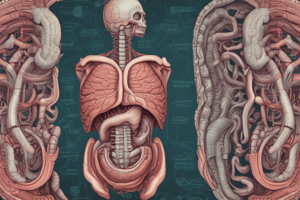Podcast
Questions and Answers
機械消化的過程包括哪些物理動作?
機械消化的過程包括哪些物理動作?
- 咀嚼食物和胃內攪拌 (correct)
- 消化酶分解食物
- 腸道蠕動和膽鹽乳化 (correct)
- 顆粒食物直接被吸收
以下哪一項不是化學消化的特點?
以下哪一項不是化學消化的特點?
- 由機械動作完成 (correct)
- 生成可被吸收的小分子
- 水解複雜食物
- 利用消化酶的作用
唾液的功能主要是?
唾液的功能主要是?
- 分解蛋白質
- 消化澱粉 (correct)
- 促進食物攝取
- 乳化脂肪
什麼是胺基酸的來源?
什麼是胺基酸的來源?
以下哪項正確描述了化學消化的過程?
以下哪項正確描述了化學消化的過程?
膽鹽在小腸中的作用是?
膽鹽在小腸中的作用是?
以下哪種酶負責將碳水化合物分解為單糖?
以下哪種酶負責將碳水化合物分解為單糖?
在消化的過程中,產品何時能被腸道吸收?
在消化的過程中,產品何時能被腸道吸收?
小腸的結構特徵如何幫助食物的吸收?
小腸的結構特徵如何幫助食物的吸收?
絨毛上的微絨毛的主要作用是什麼?
絨毛上的微絨毛的主要作用是什麼?
為何小腸的絨毛有助於維持陡峭的濃度梯度?
為何小腸的絨毛有助於維持陡峭的濃度梯度?
小腸表面積增大的好處主要是為了什麼?
小腸表面積增大的好處主要是為了什麼?
小腸的薄上皮層對吸收過程有何影響?
小腸的薄上皮層對吸收過程有何影響?
食物在消化道內是如何被推進至肛門的?
食物在消化道內是如何被推進至肛門的?
為什麼食物需要經過消化才能進入循環系統?
為什麼食物需要經過消化才能進入循環系統?
蠕動的主要功能是什麼?
蠕動的主要功能是什麼?
在食物向前運動的過程中,食團的前端發生了什麼?
在食物向前運動的過程中,食團的前端發生了什麼?
哪些分子可以直接被身體吸收?
哪些分子可以直接被身體吸收?
什麼是蠕動的本質特徵?
什麼是蠕動的本質特徵?
消化道壁的肌肉是如何協同工作的?
消化道壁的肌肉是如何協同工作的?
消化過程中,食物最終會轉變成什麼形式以便進入循環系統?
消化過程中,食物最終會轉變成什麼形式以便進入循環系統?
乳齒和恆齒的主要區別是什麼?
乳齒和恆齒的主要區別是什麼?
吞嚥過程中,食團進入食道的先決條件是什麼?
吞嚥過程中,食團進入食道的先決條件是什麼?
在吞嚥之前,舌頭的作用是什麼?
在吞嚥之前,舌頭的作用是什麼?
恆齒中位於最後的臼齒是什麼?
恆齒中位於最後的臼齒是什麼?
食物在消化道中的運動是透過哪種方式進行的?
食物在消化道中的運動是透過哪種方式進行的?
在吞嚥過程中,哪個部位會覆蓋氣管的開口?
在吞嚥過程中,哪個部位會覆蓋氣管的開口?
乳齒中缺少哪種牙齒?
乳齒中缺少哪種牙齒?
在吞嚥過程中,舌頭的主要功能是什麼?
在吞嚥過程中,舌頭的主要功能是什麼?
食物在大腸內的主要作用是什麼?
食物在大腸內的主要作用是什麼?
盲腸在人體內的功能是什麼?
盲腸在人體內的功能是什麼?
在小腸內,食物的吸收主要發生在哪裡?
在小腸內,食物的吸收主要發生在哪裡?
碳酸氫鈉在消化過程中主要的作用是什麼?
碳酸氫鈉在消化過程中主要的作用是什麼?
當食物通過小腸後,消化的狀態是什麼?
當食物通過小腸後,消化的狀態是什麼?
草食性動物的盲腸功能為何特別明顯?
草食性動物的盲腸功能為何特別明顯?
以下哪項不是小腸的適應用於食物吸收的結構特徵?
以下哪項不是小腸的適應用於食物吸收的結構特徵?
消化酶的作用主要在小腸中,以下哪種選項描述了正確的消化過程?
消化酶的作用主要在小腸中,以下哪種選項描述了正確的消化過程?
糞便在排出體外之前的儲存地是什麼?
糞便在排出體外之前的儲存地是什麼?
消化液的主要功能是什麼?
消化液的主要功能是什麼?
小腸中所有消化酶中哪一種與澱粉的消化有關?
小腸中所有消化酶中哪一種與澱粉的消化有關?
小腸的鹼性環境對消化的影響是什麼?
小腸的鹼性環境對消化的影響是什麼?
最終大腸的水分吸收會影響什麼?
最終大腸的水分吸收會影響什麼?
結腸和直腸不涉及哪一種功能?
結腸和直腸不涉及哪一種功能?
小腸吸收水份的主要途徑是透過什麼方式?
小腸吸收水份的主要途徑是透過什麼方式?
為什麼澱粉無法透過透析管進入周圍的水中?
為什麼澱粉無法透過透析管進入周圍的水中?
唾液中的哪種酵素負責將澱粉消化成小的麥芽糖分子?
唾液中的哪種酵素負責將澱粉消化成小的麥芽糖分子?
在模擬消化和吸收的實驗中,透析管的用途是什麼?
在模擬消化和吸收的實驗中,透析管的用途是什麼?
當小腸吸收已消化食物後,腸腔內的水勢會發生什麼變化?
當小腸吸收已消化食物後,腸腔內的水勢會發生什麼變化?
在進行對照實驗時,為什麼應該使用煮沸的唾液?
在進行對照實驗時,為什麼應該使用煮沸的唾液?
在實驗中,為什麼沒有發現澱粉而只發現還原糖?
在實驗中,為什麼沒有發現澱粉而只發現還原糖?
PVC膠管能否用於模擬小腸吸收的對照實驗?
PVC膠管能否用於模擬小腸吸收的對照實驗?
Flashcards
乳齿
乳齿
从出生到两岁期间长出的牙,在6至12岁期间会脱落。
恒齿
恒齿
在6至12岁期间替换乳齿的牙,一旦脱落后就不会再生长。
口腔咀嚼
口腔咀嚼
吞嚥的第一个步骤,舌头将食物混合唾液形成食团。
舌头推食团
舌头推食团
Signup and view all the flashcards
软腭升起
软腭升起
Signup and view all the flashcards
喉部上升
喉部上升
Signup and view all the flashcards
食团进入食道
食团进入食道
Signup and view all the flashcards
蠕动
蠕动
Signup and view all the flashcards
小腸的消化吸收功能
小腸的消化吸收功能
Signup and view all the flashcards
絨毛的功能
絨毛的功能
Signup and view all the flashcards
絨毛的結構特徵
絨毛的結構特徵
Signup and view all the flashcards
絨毛壁的結構特徵
絨毛壁的結構特徵
Signup and view all the flashcards
絨毛內的運輸系統
絨毛內的運輸系統
Signup and view all the flashcards
消化道壁肌肉
消化道壁肌肉
Signup and view all the flashcards
蠕动是如何发生的?
蠕动是如何发生的?
Signup and view all the flashcards
管腔
管腔
Signup and view all the flashcards
消化
消化
Signup and view all the flashcards
为什么需要消化?
为什么需要消化?
Signup and view all the flashcards
哪些物质可以直接被吸收?
哪些物质可以直接被吸收?
Signup and view all the flashcards
消化道壁的差异透性
消化道壁的差异透性
Signup and view all the flashcards
機械消化是什麼?
機械消化是什麼?
Signup and view all the flashcards
化學消化是什麼?
化學消化是什麼?
Signup and view all the flashcards
食物在口腔中怎樣被消化?
食物在口腔中怎樣被消化?
Signup and view all the flashcards
唾液有什麼作用?
唾液有什麼作用?
Signup and view all the flashcards
碳水化合物酶有什麼作用?
碳水化合物酶有什麼作用?
Signup and view all the flashcards
蛋白酶有什麼作用?
蛋白酶有什麼作用?
Signup and view all the flashcards
脂肪酶有什麼作用?
脂肪酶有什麼作用?
Signup and view all the flashcards
膽汁有什麼作用?
膽汁有什麼作用?
Signup and view all the flashcards
食物吸收位置
食物吸收位置
Signup and view all the flashcards
小腸適應食物吸收的構造特徵 - 長度
小腸適應食物吸收的構造特徵 - 長度
Signup and view all the flashcards
小腸適應食物吸收的構造特徵 - 絨毛
小腸適應食物吸收的構造特徵 - 絨毛
Signup and view all the flashcards
小腸適應食物吸收的構造特徵 - 皺襞
小腸適應食物吸收的構造特徵 - 皺襞
Signup and view all the flashcards
小腸適應食物吸收的構造特徵 - 微絨毛
小腸適應食物吸收的構造特徵 - 微絨毛
Signup and view all the flashcards
小腸適應食物吸收的構造特徵 - 血管和淋巴管
小腸適應食物吸收的構造特徵 - 血管和淋巴管
Signup and view all the flashcards
碳酸氫鈉的作用
碳酸氫鈉的作用
Signup and view all the flashcards
碳酸氫鈉和胃酸
碳酸氫鈉和胃酸
Signup and view all the flashcards
膽汁
膽汁
Signup and view all the flashcards
膽鹽的作用
膽鹽的作用
Signup and view all the flashcards
胰液
胰液
Signup and view all the flashcards
胰蛋白酶的作用
胰蛋白酶的作用
Signup and view all the flashcards
胰澱粉酶的作用
胰澱粉酶的作用
Signup and view all the flashcards
胰脂肪酶的作用
胰脂肪酶的作用
Signup and view all the flashcards
消化道的水分吸收
消化道的水分吸收
Signup and view all the flashcards
肠腔水势与水分吸收
肠腔水势与水分吸收
Signup and view all the flashcards
透析管模拟实验
透析管模拟实验
Signup and view all the flashcards
淀粉分解和麦芽糖吸收
淀粉分解和麦芽糖吸收
Signup and view all the flashcards
消化道壁的差异性透性
消化道壁的差异性透性
Signup and view all the flashcards
消化实验的控制实验
消化实验的控制实验
Signup and view all the flashcards
吸收实验的控制实验
吸收实验的控制实验
Signup and view all the flashcards
消化道壁的选择性透性
消化道壁的选择性透性
Signup and view all the flashcards
Study Notes
Nutrition in Humans
- Humans require nutrients for life maintenance.
- Nutrition is the process of obtaining and using nutrients for life.
- Nutrition methods vary among organisms. Humans are heterotrophs relying on other organisms for food.
Digestion and Absorption
-
Ingestion is the intake of food into the mouth and subsequent alimentary canal.
-
Digestion breaks down food into smaller, simpler, soluble molecules for absorption.
-
Mechanical digestion involves physical processes like chewing and churning
-
Chemical digestion involves enzymes for breaking down larger molecules.
- Carbohydrates are digested into simple sugars.
- Proteins are digested into peptides and amino acids.
- Lipids are digested into fatty acids and glycerol.
-
Absorption occurs through the alimentary canal wall into the circulatory system.
-
The absorbed nutrients are then transported throughout the body.
-
Assimilation is the use of absorbed nutrients by body cells for metabolism.
-
Egestion removes undigested material as feces.
The Human Digestive System
- The human digestive system comprises the alimentary canal and associated glands.
- The alimentary canal includes the mouth, pharynx, esophagus, small intestine (duodenum, ileum), large intestine (caecum, colon, rectum), and the anus.
- Associated glands: salivary glands, pancreas, liver
Teeth Types
- Mammals have four types of teeth for different functions.
- Incisors are used for biting and cutting food.
- Canines are used for killing prey and tearing flesh.
- Premolars and molars are used for grinding and crushing food.
Food Movement
- Swallowing moves food from the mouth to the esophagus.
- Peristalsis is the wave-like muscular movement that pushes food through the alimentary canal.
Digestion in different parts of Alimentary Canal
- Buccal cavity: Mechanical digestion (chewing) by teeth; chemical digestion (saliva) by amylase.
- Stomach: Mechanical digestion (churning); chemical digestion (hydrochloric acid & protease)
- Small intestine: Chemical digestion (pancreatic juice with amylase, protease, lipase; intestinal juice with enzymes).
- Large intestine: Water absorption; mineral and vitamin absorption.
Absorption in Small Intestine
- Villi in the small intestine increase the surface area for absorption.
- Nutrients diffuse or are actively transported into blood and lymph vessels.
- Blood transports absorbed simple sugars, amino acids, minerals, and water-soluble vitamins.
- Lymph transports absorbed fatty acids and glycerol.
Liver Role
- The liver plays a crucial role in controlling blood glucose levels by converting glucose to glycogen.
- The liver converts excess glucose to glycogen for storage.
Studying That Suits You
Use AI to generate personalized quizzes and flashcards to suit your learning preferences.




